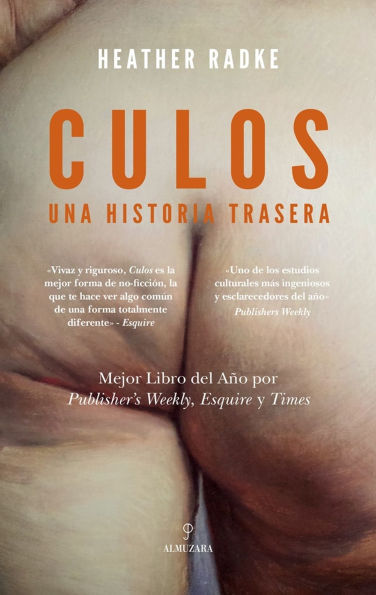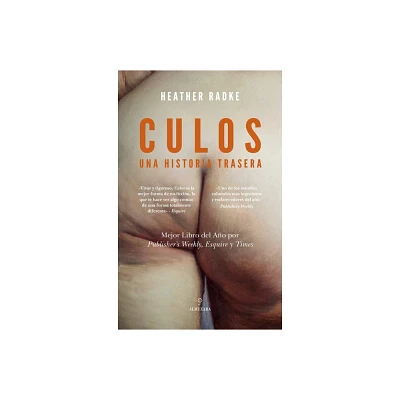Home
Culos: Una historia trasera
Loading Inventory...
Barnes and Noble
Culos: Una historia trasera
Current price: $23.95


Barnes and Noble
Culos: Una historia trasera
Current price: $23.95
Loading Inventory...
Size: OS
*Product Information may vary - to confirm product availability, pricing, and additional information please contact Barnes and Noble
Los amemos u odiemos, pensemos que son sexis o extraños, los podamos considerar demasiado grandes o demasiado pequeños, o todo lo contrario, la humanidad mantiene una relación complicada con los culos. Es una parte del cuerpo que sólo nuestra especie posee, clave para su evolución y supervivencia, y aún así ha llegado a significar mucho más: sexo, deseo, humor, vergüenza. Esta historia cultural nos lleva desde las salas de espectáculos del Londres del siglo XIX hasta los estudios de aeróbic de la década de los ochenta, desde aquel Baby Got Back de Sir Mix-a-Lot a las montañas de Arizona, donde cada año humanos y caballos compiten en una hazaña de resistencia de sus glúteos. Biólogos evolutivos que estudian cómo se desarrollaron los primeros traseros, modelos cuyas medidas han definido la talla de vaqueros para millones de mujeres, y gurús del fitness que crearon tendencia, el presente libro también pone el foco en el sesgo racial a través de figuras como Sarah Bartmann, Josephine Baker, Jennifer López y otras mujeres cuyos traseros han sido idolatrados, envidiados y despreciados. Parte profunda investigación, parte viaje personal y parte gabinete de curiosidades, esta es una entretenida, reveladora y reflexiva exploración de por qué ciertas formas se ponen y pasan de moda, y cómo nuestras concepciones sobre la raza, el control, la liberación y el poder afectan a nuestra percepción sobre nosotros mismos y los demás.
Whether we love them or hate them, think they're sexy or weird, consider them too big or too small or the complete opposite, humanity has a complicated relationship with butts. It's a body part that only our species possesses, key to its evolution and survival, and yet it has come to mean so much more: sex, desire, humor, shame. This cultural history takes us from the showrooms of 19th-century London to the aerobics studios of the 1980s, from Sir Mix-a-Lot's Baby Got Back to the mountains of Arizona, where humans and horses compete each year in a feat of gluteal endurance. From evolutionary biologists studying how the first butts developed, to models whose measurements have defined jean size for millions of women, to fitness gurus who created trends, this book also shines a light on racial bias through figures such as Sarah Bartmann, Josephine Baker, Jennifer Lopez, and other women whose behinds have been idolized, envied, and scorned. Part deep investigation, part personal journey, and part cabinet of curiosities, this is an entertaining, revealing, and thoughtful exploration of why certain shapes come in and out of fashion, and how our conceptions of race, control, liberation, and power affect our perceptions of ourselves and others.
Whether we love them or hate them, think they're sexy or weird, consider them too big or too small or the complete opposite, humanity has a complicated relationship with butts. It's a body part that only our species possesses, key to its evolution and survival, and yet it has come to mean so much more: sex, desire, humor, shame. This cultural history takes us from the showrooms of 19th-century London to the aerobics studios of the 1980s, from Sir Mix-a-Lot's Baby Got Back to the mountains of Arizona, where humans and horses compete each year in a feat of gluteal endurance. From evolutionary biologists studying how the first butts developed, to models whose measurements have defined jean size for millions of women, to fitness gurus who created trends, this book also shines a light on racial bias through figures such as Sarah Bartmann, Josephine Baker, Jennifer Lopez, and other women whose behinds have been idolized, envied, and scorned. Part deep investigation, part personal journey, and part cabinet of curiosities, this is an entertaining, revealing, and thoughtful exploration of why certain shapes come in and out of fashion, and how our conceptions of race, control, liberation, and power affect our perceptions of ourselves and others.

















